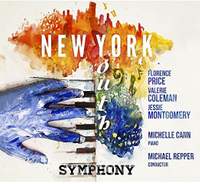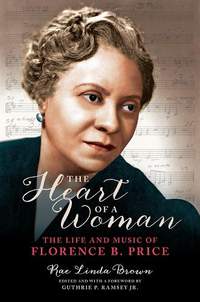Interview,
Michael Repper on New York Youth Symphony
It's quite something for a youth orchestra to scoop a Grammy for its debut recording, and the achievement of the New York Youth Symphony (who won Best Orchestral Performance at last month's ceremony) is all the more remarkable given that the project was rehearsed and recorded in 2020, with stringent lockdown-restrictions in place. Featuring Florence Price's tone-poem Ethiopia's Shadow in America and Piano Concerto in One Movement (which receives its premiere recording in the composer's original orchestration), Valerie Coleman's Umoja: Anthem of Unity and Jessie Montgomery's Soul Force, the album was released on Avie last spring, and was described by Gramophone as 'a heartening indication of innocent ears opening to both the undiscovered and the entirely new'.
Once their conductor Michael Repper's feet had touched the ground after their win (and the ensuing flurry of press-requests!), he took some time out from preparations for his final concerts as Music Director to answer a few questions about the orchestra's mission to amplify marginalised voices, how they built a relationship with the two living composers featured on the album despite being physically separated during lockdown, and the backstory behind Price's 'magnificent' concerto...
Tell me a little about NYYS's philosophy, and in particular your evident commitment to diversity in terms of both programming and recruitment?
Even before I became the music director of the New York Youth Symphony, I admired how this organization takes to heart its commitment to the community in diverse and vibrant ways, including its evolving partnerships, in-school residencies, free community concerts, access funds, and fellowships. Every day, NYYS honors one of its core values: that everyone should be included in their musical education regardless of their ability to pay.
My partnership with New York Youth Symphony has been a match made in heaven as my mission as an artist is to use music as a vehicle for positive change. Classical music needs more equitable representation, within our ensembles, audiences and repertoire choices.
This is important work and it continues. New York Youth Symphony has provided aid, fellowships, and mentorships to young musicians from underserved communities for decades. And going back over thirty years, New York Youth Symphony has commissioned and performed at least one world premiere from young composers of all backgrounds at every single concert. These are just a few of the regular intentional activities of NYYS that pre-date this album and which will continue into the future.
Working towards an equitable and representative field is a basic responsibility for professional musicians.
The pandemic must've been a challenging time for the orchestra to make its debut recording! How did you manage to keep activities going during the lockdowns, and what were the logistical challenges involved in making the recording happen?
Absolutely! This project stemmed from a desire to maintain our musical activities in a way that could be engaging and safe for our musicians, despite the challenges of the pandemic. While performances were canceled, to me and to NYYS, doing nothing was not an option. So, I asked, “what can we do that would still be a genuine experience for the young musicians?” Recording came to mind instantly.
Of course, this was November 2020, pre-vaccine. We had to design a new way to rehearse and record, because we couldn’t gather safely in large groups, or for lengthy periods of time. It may be the only Grammy-winning album that was originally rehearsed on Google Drive and Zoom. We actually had very few rehearsals in person before the recording sessions, because we were aware that gathering in person posed a physical risk. The marvelous young musicians rose to the challenge and arrived to our limited in-person rehearsals, which totaled about four hours over the span of as many weeks, completely prepared and ready to go!
It was calculated that 30 people could safely be in the room at any given time if we were all masked, and about 20 if some people had to be unmasked (woodwinds and brass, for example). To give an idea of the scale, we met in a room that easily fits 150 people in normal circumstances. We recorded in three groups: two groups of strings each with about 25 players, and one group of woodwinds, brass, and percussion, with about 20 players. The recording was layered, with the strings recording first, and the woodwinds, brass, and percussion recording over the top. While this is a very common way of recording in many genres of music, it is very uncommon in classical music. Still, it was the only way to do it at the time, and I’m so proud of our unbelievable production team led by Judith Sherman (who also won a Grammy this year for Producer of the Year!) and the orchestra for making it the best that it could be!
And, not a single person contracted the virus!
The original version of Price's Piano Concerto in One Movement was only rediscovered very recently: how much do we know about the history of the piece and its reception?
The concerto was premiered in 1934 at Orchestra Hall in Chicago, with Price herself as the soloist. It was performed several other times in 1934, for example in Pittsburgh and with the Woman’s Symphony Orchestra of Chicago. At each performance, the piece was incredibly well received by both the press and the attendees, which makes it all the more inexcusable that the concerto was simply ignored for the decades that followed.
I’m following the lead of many others, including the Catalyst Quartet, in using the term “uncovered” instead of “rediscovered” when it comes to describing this concerto and other works by Florence Price, because her work wasn’t inadvertently lost. It fell out of memory as a result of systemic issues, including the fact that works by Black women have not been adequately represented in musical performances throughout history. There is an excellent essay by the musicologist Rae Linda Brown in the Summer 1993 issue of the journal American Music, which outlines the full history of Price’s Concerto, as well as the Women’s Symphony Orchestra of Chicago. I highly recommend everyone read that article for a more in-depth look at the history of this magnificent concerto! I also am looking forward to reading Dr. Brown’s biography Florence Price, The Heart of a Woman.
How much does Price's own orchestration differ from the reconstruction which Trevor Weston prepared before the original version came to light?
Great composers have a voice. Music by great composers is recognizable because of their voice and musical vocabulary. Price’s voice absolutely comes through in Weston’s orchestration, which is wonderfully performed by Karen Walwyn and the New Black Music Repertory Ensemble in their 2011 recording.
The most striking difference between Weston’s reconstruction and Price’s original, which we perform on our album, is the middle 'Adagio' section. In Price’s original, the Adagio is dominated by the most glorious duet for oboe and piano, a sparseness which juxtaposes beautifully with the lush romanticism and large orchestration of the opening section. Strings join midway through only in a supporting role, and the pianist is given ultimate flexibility leading up to the cathartic D major climax before the up-tempo final section begins. This section is my favorite part of our album, and Michelle Cann plays it beautifully along with our 18-year-old oboist Kara Poling.
How do you go about rehearsing and contextualising (for audience and players alike) a piece like Ethiopia's Shadow in America, which deals so explicitly with the history of racial injustice in America?
Ethiopia’s Shadow in America is already contextualized perfectly by Florence Price herself in her notes, which are printed directly in the score. In her words, the movements convey:
I. The Arrival of the Negro in America When First Brought Here as a Slave
II. His Resignation and Faith
III. His Adaptation: A Fusion of His Native and Acquired Impulses
These themes are so clearly composed into the music by Florence Price herself, and so I didn’t need to further contextualize its meaning. Racial injustice is tragically a part of both our past and present. We are lucky to be able to have this music and her words, as reminders of the ugly truth of this aspect of our country’s past as we strive to build an equitable society for the future. Price faced so many barriers to having her music performed or even considered during her lifetime. I see my role as making sure we listen to and center the voices of members of communities who experience injustices. I want to make sure I am using my place on the podium to do just that.
Did you already have personal connections with Valerie Coleman and Jessie Montgomery, and how involved were they during the recording-process: were they able to attend the rehearsals and/or sessions and provide creative input?
I had a wonderful time getting to know Valerie and Jessie as best I could throughout this process. We are very proud to say that Jessie is also a NYYS alumna! While the nature of the pandemic prevented Valerie and Jessie from being present in person during the actual recording process, we were so grateful for their support and trust in us throughout the process. Jessie even met with the orchestra on Zoom in preparation for Soul Force, and both composers have reached out to congratulate the wonderful young musicians. Of course, Valerie and Jessie share in this win as well, as do Michelle Cann and Florence Price. We are so thankful for the gifts they have given the world through their music and performance!
What's coming up next for NYYS - both in concert and in the studio?
We have so many wonderful things coming up! Anyone who is close to New York City should definitely not miss our upcoming two concerts at Carnegie Hall, which are the final two of my tenure as Music Director. The first is on March 19th, and it actually features Michelle Cann in her Carnegie Hall debut. How is that for serendipity? Michelle will play Robert Schumann’s epic piano concerto, we will premiere a new work by the talented young composer Bobby Ge, and give what will be the second-ever performance in Carnegie Hall of Florence Price’s Symphony No. 1.
May 28th is our season finale, which will feature a world premiere by another talented young composer Sofía Rocha, Bernstein’s Chichester Psalms, and Mahler’s Symphony No. 1. We also have a few very exciting projects both on television and in the recording studio in the works. We can’t announce them yet but certainly will soon! Please stay tuned to NYYS on social media and at our website. You can also learn about my personal activities at www.mikerepper.com.
Michelle Cann (piano), New York Youth Symphony, Michael Repper
Available Formats: CD, MP3, FLAC, Hi-Res FLAC
Rae Linda Brown
Available Format: Book




